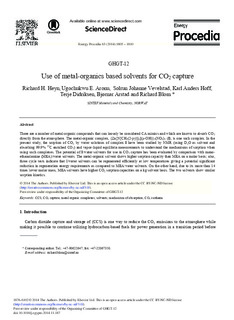| dc.contributor.author | Heyn, Richard H | |
| dc.contributor.author | Aronu, Ugochukwu Edwin | |
| dc.contributor.author | Vevelstad, Solrun Johanne | |
| dc.contributor.author | Hoff, Karl Anders | |
| dc.contributor.author | Didriksen, Terje | |
| dc.contributor.author | Arstad, Bjørnar | |
| dc.contributor.author | Blom, Richard | |
| dc.date.accessioned | 2019-09-02T09:48:15Z | |
| dc.date.available | 2019-09-02T09:48:15Z | |
| dc.date.created | 2015-01-05T10:37:36Z | |
| dc.date.issued | 2014 | |
| dc.identifier.citation | Energy Procedia. 2014, 63 1805-1810. | nb_NO |
| dc.identifier.issn | 1876-6102 | |
| dc.identifier.uri | http://hdl.handle.net/11250/2611981 | |
| dc.description.abstract | There are a number of metal-organic compounds that can loosely be considered CA mimics and which are known to absorb CO2 directly from the atmosphere. The metal-organic complex, {Zn[N[CH2(2-py)]3](μ-OH)}2(NO3)2 (I), is one such complex. In the present study, the sorption of CO2 by water solutions of complex I have been studied by NMR (using D2O as solvent and absorbing 99.9% 13C enriched CO2) and vapor-liquid equilibria measurements to understand the mechanisms of sorption when using such complexes. The potential of I/water solvents for use in CO2 capture has been evaluated by comparison with mono- ethanolamine (MEA)/water solvents. The metal-organic solvent shows higher sorption capacity than MEA on a molar basis; also, three cycle tests indicate that I/water solvents can be regenerated efficiently at low temperatures giving a potential significant reduction in regeneration energy requirements as compared to MEA/water solvents. On the other hand, due to its more than 14 times lower molar mass, MEA solvents have higher CO2 sorption capacities on a kg solvent basis. The two solvents show similar sorption kinetics. | nb_NO |
| dc.language.iso | eng | nb_NO |
| dc.publisher | Elsevier | nb_NO |
| dc.rights | Attribution-NonCommercial-NoDerivatives 4.0 Internasjonal | * |
| dc.rights.uri | http://creativecommons.org/licenses/by-nc-nd/4.0/deed.no | * |
| dc.title | Use of metal-organics based solvents for CO2 capture | nb_NO |
| dc.type | Journal article | nb_NO |
| dc.type | Peer reviewed | nb_NO |
| dc.description.version | publishedVersion | nb_NO |
| dc.rights.holder | The Authors | nb_NO |
| dc.source.pagenumber | 1805-1810 | nb_NO |
| dc.source.volume | 63 | nb_NO |
| dc.source.journal | Energy Procedia | nb_NO |
| dc.identifier.doi | 10.1016/j.egypro.2014.11.187 | |
| dc.identifier.cristin | 1190277 | |
| cristin.unitcode | 7401,80,6,7 | |
| cristin.unitcode | 7401,80,3,4 | |
| cristin.unitcode | 7401,80,3,3 | |
| cristin.unitname | Nano-og hybridmaterialer | |
| cristin.unitname | CO2 innfangningsprosesser | |
| cristin.unitname | Sorbentbaserte teknologier | |
| cristin.ispublished | true | |
| cristin.fulltext | original | |
| cristin.qualitycode | 1 | |

